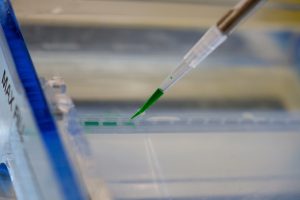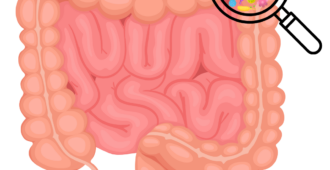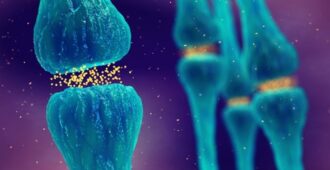During December and November the Research Development team receive a number of Christmas presents from our funded researchers. These presents come in the form of ‘annual reports’ and, although they may not be wrapped in Christmas paper, once you open them you’re sure to find a nice research surprise!

One of our PhD students, Ambra Annibali, under the leadership of Prof Chris Miller at King’s College London, shared with us a lovely gel image in their report. The ‘gel image’ in this case is what researchers call a Western Blot.
What is a blot?
A Western Blot is a technique that can be used to detect specific proteins in a sample. The reason why this can sometimes be caused a ‘gel image’ is because the researchers add the sample to a gel before they detect the proteins.
This gel is very much the same consistency as jelly, and is immersed in a special liquid. The researchers create wells at one end of the gel, in which they can add their sample (see image).
 Once a sample is added an electrical current is passed through the gel, which causes the proteins to separate along the gel depending on their size. Heavy proteins don’t move very far along the gel, but lighter proteins do. This means that researchers can quickly observe whether their sample has large or small proteins.
Once a sample is added an electrical current is passed through the gel, which causes the proteins to separate along the gel depending on their size. Heavy proteins don’t move very far along the gel, but lighter proteins do. This means that researchers can quickly observe whether their sample has large or small proteins.
The next step is to carefully transfer the separated proteins to a membrane, which can then be stained with a specific protein detecting antibody.
Using special agents in a different way
Antibodies are very special agents, and our bodies use them to destroy a specific cold or flu virus. For example, each virus has its own specific antibody (or special agent) produced by our body to destroy it. This means that this antibody can quickly and efficiently identify the virus, and stop the infection without harming any other cell (or civilians) in our body.
In the case of MND, researchers are looking at the C9orf72 inherited MND gene. The function of this gene and how it causes MND is still unknown and Ambra is looking at the resulting protein, produced by this gene. In MND, the mutation in the C9orf72 gene is believed to have a number of mechanisms. One mechanism is that the gene causes a reduction in the amount of protein within the cells. Ambra has successfully developed a new antibody that can identify the C9orf72 protein using this technique.
Ambra said: “In my Western Blot I am looking at the levels of C9orf72 protein in human cells using a new antibody I produced.
“An expansion in the C9orf72 gene was found to be a common genetic cause for inherited MND and the related disease frontotemporal dementia, but how this gene causes MND is still unclear. The aim of my work is to look at the gene product, the C9orf72 protein, and find out about its role, which is still unknown.”

More about Ambra’s research
Now that Ambra has successfully created a new antibody for detecting the C9orf72 protein she hopes to use this to determine where the C9orf72 protein is found within the motor neurones and how this protein may cause MND in some individuals.
Her initial work has discovered that a proportion of the C9ORF72 protein resides within the nucleus of the cell. The nucleus is the control centre of the cell, storing our genetic information known as DNA.
The C9orf72 protein is also found to be associated with ribosomes, which are involved in translating the genetic instructions to create new proteins (find out more about DNA and proteins here).
New Year’s resolutions
2015 is a new year for Ambra and her research. This year she has successfully developed a new antibody to detect the C9orf72 protein, but what are her plans for next year?
Ambra said: “Next year I hope to be able to use this new antibody as a new valid tool to find out more about this protein and its role in MND. By finding out more about this protein, I hope to be able to contribute greater to the MND research field, ultimately helping the Association to achieve its vision of a world free from MND.”






Thankyou Ambra. Any new finding in this research is a new hope to us. My mom is diagnosed with MND and every bit of progress on this research can be very important to us. I can’t thank this association enough for the wonderful work they are doing.